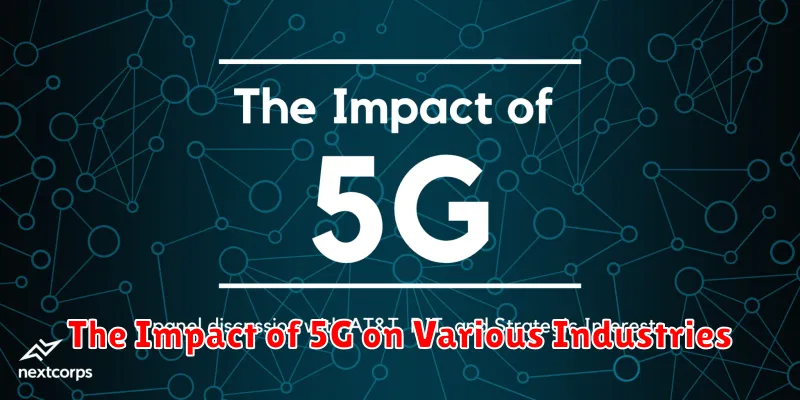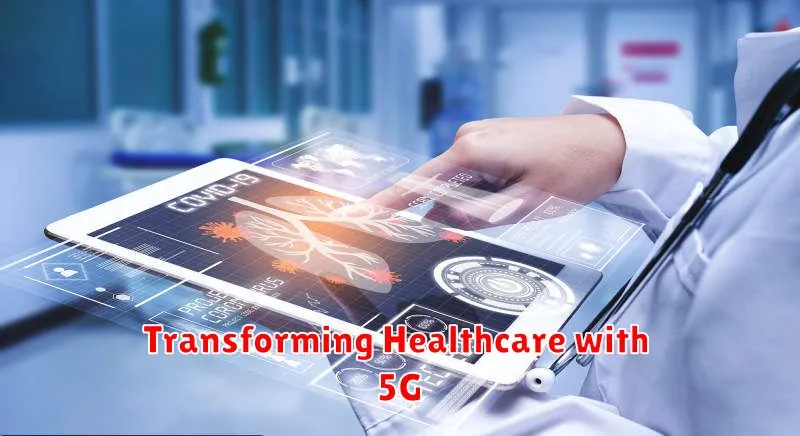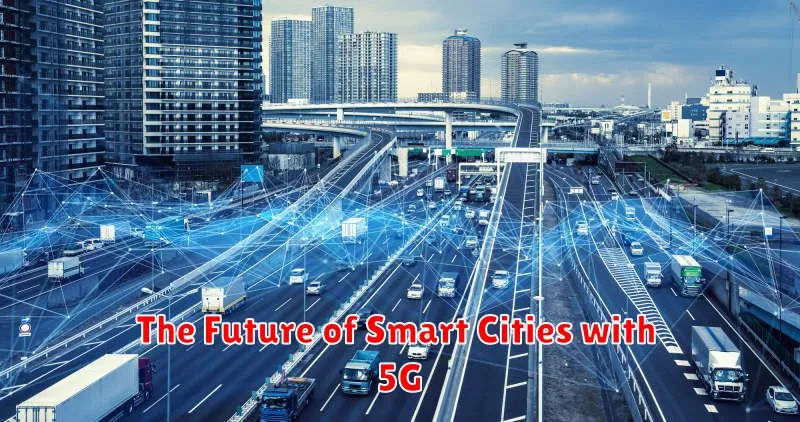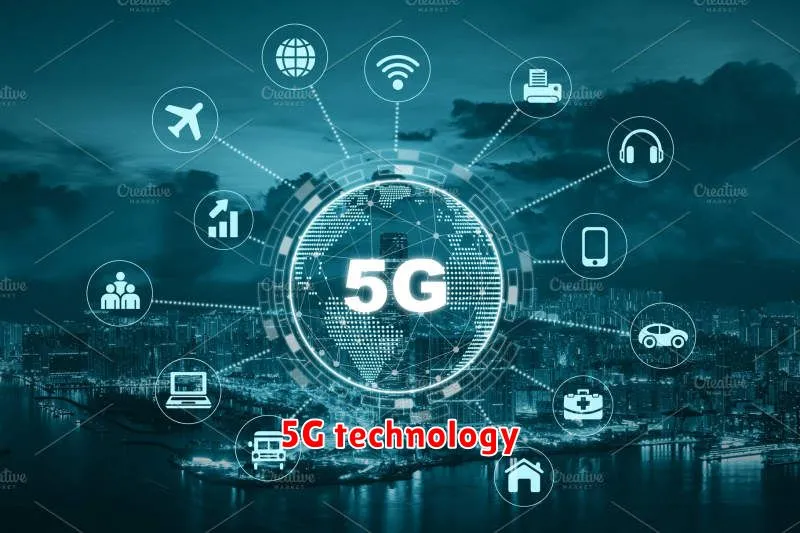The world is changing rapidly, and at the forefront of this evolution is 5G technology. More than just a faster internet connection, 5G is a revolutionary leap in connectivity that is poised to transform nearly every aspect of our lives. From the way we work and play to how we interact with our cities and even how we care for our health, 5G is ushering in a new era of innovation and opportunity.
The impact of 5G is already being felt across industries. Smart factories are becoming more efficient and automated, remote healthcare is becoming more accessible, and autonomous vehicles are closer to reality. With its lightning-fast speeds, low latency, and ability to connect billions of devices simultaneously, 5G is the catalyst for a future that was once only imaginable in science fiction. In this article, we will explore the transformative power of 5G technology and how it is reshaping our world.
Understanding the Fundamentals of 5G
In today’s rapidly evolving technological landscape, 5G has emerged as a transformative force, promising to revolutionize the way we connect and interact with the world around us. As the fifth generation of wireless cellular technology, 5G builds upon the foundation laid by its predecessors, offering significant advancements in speed, latency, and capacity. This article delves into the fundamental aspects of 5G, exploring its key features, benefits, and potential impact.
Key Features of 5G
5G technology introduces several groundbreaking features that distinguish it from previous generations:
- Enhanced Data Rates: 5G boasts significantly faster data speeds compared to 4G, with peak download rates reaching up to 20 Gbps. This translates to lightning-fast file transfers, seamless streaming, and immersive virtual reality experiences.
- Ultra-Low Latency: Latency refers to the time delay between sending and receiving data. 5G significantly reduces latency to milliseconds, enabling real-time applications such as autonomous driving, remote surgery, and industrial automation.
- Massive Connectivity: 5G supports a massive number of connected devices simultaneously, paving the way for the Internet of Things (IoT) and the proliferation of smart devices in various industries.
- Improved Energy Efficiency: 5G networks are designed to be more energy-efficient than their predecessors, reducing environmental impact and optimizing battery life for connected devices.
Benefits of 5G
The advancements brought by 5G technology unlock a multitude of benefits across diverse sectors:
- Enhanced Mobile Experience: 5G enables users to enjoy faster download speeds, smoother streaming, and improved online gaming experiences.
- Industrial Automation: 5G’s low latency and high bandwidth support real-time industrial processes, enabling automation and remote control of machinery.
- Smart Cities: 5G facilitates the development of smart cities by connecting sensors, traffic lights, and other infrastructure elements for improved efficiency and public safety.
- Healthcare Innovation: 5G empowers remote healthcare, enabling real-time monitoring, virtual consultations, and telemedicine services.
- Autonomous Vehicles: 5G’s low latency and reliability are crucial for the development and deployment of autonomous vehicles.
Impact and Future of 5G
The arrival of 5G marks a significant milestone in wireless communication, poised to reshape various aspects of our lives. Its widespread adoption is expected to drive economic growth, create new industries, and improve our quality of life. As 5G networks mature and evolve, we can anticipate further advancements in connectivity, speed, and capacity, opening up even greater possibilities.
Increased Speed and Bandwidth: A Game Changer
In today’s digital age, speed and bandwidth are paramount. They are the lifeblood of our online experiences, influencing everything from streaming video to downloading large files. As technology advances, we’re witnessing a remarkable increase in both speed and bandwidth, transforming the way we interact with the digital world. This article explores the profound impact of increased speed and bandwidth, examining its implications across various sectors and the exciting possibilities it unlocks.
One of the most tangible benefits of increased speed and bandwidth is the seamless streaming of high-quality video content. Gone are the days of buffering and pixelated images. With faster connections, we can enjoy crystal-clear visuals and immersive experiences, whether watching movies, playing video games, or attending virtual meetings. This enhanced streaming capability has revolutionized the entertainment industry, allowing for more realistic graphics, interactive gameplay, and engaging live events.
The impact extends beyond entertainment. In the realm of e-commerce, increased speed and bandwidth have significantly improved the customer experience. Websites load faster, online transactions are completed seamlessly, and customers can browse product catalogs with minimal lag. This translates to increased sales, enhanced customer satisfaction, and a more competitive online landscape.
Furthermore, increased speed and bandwidth are crucial for the growth of cloud computing. As businesses increasingly rely on cloud-based services, the ability to transfer large amounts of data quickly and efficiently is essential. Faster connections allow for seamless data storage, retrieval, and processing, enabling businesses to operate more effectively and scale their operations with ease.
Beyond individual users and businesses, the impact of increased speed and bandwidth is felt on a societal level. In the field of education, faster connections facilitate remote learning opportunities, making education more accessible to individuals in remote areas. Students can access online courses, interact with teachers virtually, and engage in collaborative learning activities, regardless of their physical location.
In the realm of healthcare, increased speed and bandwidth enable advancements in telemedicine, allowing patients to consult with doctors remotely and receive virtual treatment. This is particularly beneficial in rural areas where access to specialists is limited. Faster connections also facilitate the transmission of medical images, enabling accurate diagnosis and timely treatment.
The benefits of increased speed and bandwidth are undeniable, but it’s important to acknowledge the challenges associated with this technological advancement. As our reliance on the internet grows, so too does the risk of cyberattacks and data breaches. Ensuring robust security measures and data protection protocols is crucial to mitigate these risks and safeguard our digital lives.
Furthermore, access to high-speed internet remains a challenge in certain regions, creating a digital divide that must be addressed. Governments and organizations need to invest in infrastructure development and initiatives to ensure equitable access to the benefits of increased speed and bandwidth.
In conclusion, the rise of increased speed and bandwidth is a transformative force, redefining our digital experiences and unlocking unprecedented possibilities. It has revolutionized industries, enhanced communication, and expanded access to information and resources. As technology continues to advance, we can expect even faster speeds and greater bandwidth, further accelerating the digital revolution and shaping our future.
Ultra-Low Latency: Enabling Real-Time Applications
In the realm of modern technology, where information flows at lightning speed, latency has become a critical factor determining the success or failure of numerous applications. Latency refers to the time delay between an action and its response, and for certain applications, even milliseconds can make a world of difference. Ultra-low latency, characterized by delays measured in microseconds or even nanoseconds, is a crucial requirement for enabling real-time applications that demand instantaneous responses and seamless interactions.
The Importance of Ultra-Low Latency
Ultra-low latency is essential for a wide range of applications, particularly those that operate in real-time environments. Here are some key areas where it plays a pivotal role:
- Financial Trading: In high-frequency trading, milliseconds can mean the difference between profit and loss. Ultra-low latency ensures that traders can execute orders and react to market fluctuations with minimal delay, maximizing their chances of success.
- Gaming: For online multiplayer games, a smooth and responsive experience is crucial. Ultra-low latency minimizes lag, ensuring players can react quickly to events and enjoy a seamless gaming experience.
- Autonomous Vehicles: Self-driving cars rely on real-time data processing to navigate safely. Ultra-low latency is vital for processing sensor data, making decisions, and responding to changing road conditions.
- Telemedicine: Remote surgery and other telemedicine applications require ultra-low latency to enable real-time communication between surgeons and patients, facilitating precise and safe procedures.
- Internet of Things (IoT): As the number of connected devices grows, ultra-low latency becomes increasingly important for seamless communication and data exchange between devices.
Achieving Ultra-Low Latency
Achieving ultra-low latency requires a multifaceted approach that involves optimizing hardware, software, and network infrastructure. Some key strategies include:
- High-Performance Computing: Utilizing powerful processors, specialized hardware, and optimized algorithms to accelerate data processing and minimize delays.
- Fiber Optic Networks: Employing fiber optic cables for high-speed data transmission, reducing signal degradation and latency compared to traditional copper cables.
- Edge Computing: Processing data closer to the source, minimizing the distance data needs to travel and reducing latency.
- Network Optimization: Implementing routing protocols, traffic management, and network virtualization techniques to streamline data flow and reduce congestion.
- Software Optimization: Developing efficient algorithms, minimizing code execution time, and optimizing software for specific hardware platforms.
Conclusion
Ultra-low latency is a critical enabler for real-time applications, driving innovation and transforming industries across the globe. By minimizing delays, we can create a world where information flows seamlessly, enabling faster decision-making, enhanced user experiences, and a plethora of new possibilities.
Enhanced Capacity and Connectivity: Supporting Billions of Devices
The relentless proliferation of connected devices, from smartphones and wearables to smart homes and industrial IoT solutions, presents a formidable challenge: accommodating the exponential growth in data traffic. This surging demand necessitates significant advancements in network infrastructure, ensuring seamless connectivity for billions of devices and a smooth flow of information.
The increasing number of connected devices puts strain on existing network infrastructure. Traditional networks, designed for a limited number of users, struggle to cope with the massive influx of data generated by these devices. The need for enhanced capacity is paramount, ensuring that networks can handle the ever-growing volume of data traffic without compromising performance.
To address this challenge, several key strategies are being employed:
- Next-Generation Network Technologies: The adoption of 5G and Wi-Fi 6, with their advanced capabilities for higher speeds, lower latency, and increased capacity, is essential for supporting the demands of a hyper-connected world. These technologies enable more devices to connect simultaneously, facilitating seamless data transmission.
- Cloud-Native Solutions: Cloud-based infrastructure offers scalability and flexibility, allowing network operators to dynamically adjust capacity to meet fluctuating demands. This approach ensures optimal resource utilization and enables rapid deployment of new services.
- Edge Computing: By processing data closer to the source, edge computing reduces latency and improves responsiveness for time-sensitive applications. This distributed approach also alleviates strain on core network infrastructure, further enhancing capacity.
Beyond capacity, connectivity is equally crucial. The ability to connect billions of devices reliably and securely across diverse environments is paramount. Network operators are investing in technologies that strengthen network resilience and extend coverage to remote areas.
- Network Slicing: This technology enables the creation of virtual networks within a physical network, allowing operators to tailor network resources to specific applications and device types. This approach optimizes network performance and ensures seamless connectivity for various use cases.
- Satellite Networks: Satellite constellations provide high-bandwidth connectivity to remote locations, expanding network coverage and bridging the digital divide. This is particularly valuable for areas with limited terrestrial infrastructure.
The convergence of enhanced capacity and connectivity paves the way for a truly interconnected future. It empowers businesses and individuals to leverage the transformative potential of the Internet of Things, unlocking new possibilities in diverse fields like healthcare, manufacturing, transportation, and smart cities.
The Impact of 5G on Various Industries

The advent of 5G technology has ushered in a new era of connectivity, promising unprecedented speeds, lower latency, and greater bandwidth. This transformative technology is poised to revolutionize numerous industries, impacting the way we live, work, and interact with the world around us. From healthcare and manufacturing to transportation and entertainment, 5G is set to reshape the landscape of these sectors, unlocking new possibilities and driving innovation.
Healthcare
In the healthcare industry, 5G will enable real-time remote monitoring of patients, facilitating faster diagnosis and treatment. Telemedicine will become more accessible and efficient, allowing for remote consultations and surgeries. 5G will also empower healthcare providers with access to vast amounts of data, enabling them to develop personalized treatment plans and conduct clinical trials more effectively.
Manufacturing
The manufacturing sector stands to benefit significantly from 5G‘s enhanced connectivity and speed. With 5G, manufacturers can implement advanced technologies like Industrial Internet of Things (IIoT) and automation, optimizing production processes, reducing downtime, and improving efficiency. 5G will also enable the development of smart factories, where machines can communicate seamlessly, leading to greater flexibility and responsiveness.
Transportation
5G is poised to revolutionize the transportation industry by enabling the development of autonomous vehicles. With 5G‘s low latency and high bandwidth, self-driving cars can communicate with each other and their surroundings in real time, ensuring safe and efficient navigation. 5G will also facilitate the implementation of smart traffic management systems, reducing congestion and improving traffic flow.
Entertainment
The entertainment industry will experience a dramatic shift with the arrival of 5G. Immersive experiences like virtual reality (VR) and augmented reality (AR) will become more accessible and realistic, thanks to 5G‘s high bandwidth and low latency. 5G will also enable streaming of high-quality video content without buffering, enhancing the viewing experience for consumers.
Conclusion
The impact of 5G on various industries is undeniable. This transformative technology will drive innovation, enhance efficiency, and create new opportunities across numerous sectors. As 5G continues to evolve, its influence on our lives will only grow, shaping the future of our society and economy.
Transforming Healthcare with 5G

The healthcare industry is undergoing a dramatic transformation, driven by technological advancements that are changing the way we diagnose, treat, and manage health conditions. At the forefront of this revolution is 5G, the next generation of wireless technology, which promises to revolutionize healthcare by enabling unprecedented connectivity, speed, and reliability.
Enhanced Connectivity: 5G offers lightning-fast speeds and low latency, making it ideal for real-time data transmission. This enables remote patient monitoring, telehealth consultations, and the seamless exchange of medical images and data. Doctors can access patient records and vital signs remotely, improving diagnostic accuracy and treatment plans.
Internet of Medical Things (IoMT): 5G facilitates the connectivity of medical devices, sensors, and wearables, creating an Internet of Medical Things (IoMT). This allows for continuous monitoring of patients’ health, early detection of health issues, and proactive interventions. Smart sensors can track vital signs, medication adherence, and even environmental factors affecting health.
Telehealth and Remote Patient Monitoring: 5G empowers telehealth services, enabling patients to consult with doctors remotely via video calls and virtual visits. This is particularly beneficial for patients in rural areas or those with limited mobility. Remote patient monitoring devices can transmit real-time data to healthcare providers, allowing for timely interventions and personalized care.
Artificial Intelligence (AI) and Machine Learning (ML): 5G’s high bandwidth and processing power support the development and deployment of AI and ML algorithms in healthcare. These technologies can analyze large datasets of patient information to identify patterns, predict health outcomes, and personalize treatment plans. AI-powered diagnostics and drug discovery are transforming healthcare delivery.
Robotics and Surgery: 5G enables the development of advanced robotic systems for surgery, allowing for minimally invasive procedures and greater precision. Remote surgery using 5G-powered robots can provide access to specialized surgeons regardless of location, improving patient outcomes and reducing wait times.
Conclusion: 5G is poised to revolutionize healthcare by facilitating seamless connectivity, enabling innovative technologies, and empowering healthcare providers to deliver more efficient and personalized care. From remote monitoring to AI-powered diagnostics and robotic surgery, 5G is transforming the future of healthcare, ultimately improving patient outcomes and enhancing overall well-being.
Revolutionizing Manufacturing with 5G

The manufacturing industry is on the cusp of a transformative era, fueled by the advent of 5G technology. This next-generation wireless network promises to revolutionize operations, boost efficiency, and unlock new possibilities for manufacturers across the globe.
Enhanced Connectivity and Speed
At the heart of 5G’s impact is its ability to deliver ultra-fast speeds and low latency. This translates to seamless data transmission, enabling real-time monitoring and control of manufacturing processes. Imagine robots and machines communicating effortlessly, responding instantly to changes, and optimizing performance in real time.
The Rise of Smart Factories
5G is paving the way for the emergence of smart factories, where machines, sensors, and data are interconnected, creating a dynamic and responsive ecosystem. This interconnectedness allows manufacturers to gather vast amounts of data, enabling predictive maintenance, process optimization, and streamlined workflows.
Empowering the Internet of Things (IoT)
The proliferation of IoT devices in manufacturing is poised to be dramatically enhanced by 5G. From sensors monitoring equipment condition to robots collaborating on complex tasks, 5G provides the reliable and secure connectivity necessary for seamless IoT integration.
Unlocking Remote Collaboration and Automation
5G facilitates remote collaboration, allowing engineers and technicians to remotely access and control manufacturing processes. This not only reduces downtime but also enables the deployment of skilled workers across geographical boundaries. Additionally, the high bandwidth and low latency of 5G empower advanced automation, enabling the use of robots and autonomous systems for tasks that were previously impossible.
A Catalyst for Innovation
5G is more than just a technological upgrade; it’s a catalyst for innovation in manufacturing. It opens up new possibilities for augmented reality (AR) and virtual reality (VR) applications, enabling manufacturers to enhance training, design processes, and improve product quality.
Conclusion
The impact of 5G on manufacturing is undeniable. Its ability to connect, empower, and accelerate operations is transforming the industry, driving efficiency, productivity, and innovation. As 5G continues to evolve, manufacturers who embrace this technology will be positioned to thrive in the future of industrial production.
Enhancing Transportation with 5G

The arrival of 5G has ignited a revolution in various sectors, and transportation is no exception. This next-generation wireless technology is poised to transform the way we travel, making it more efficient, safe, and connected. With its lightning-fast speeds, low latency, and massive bandwidth, 5G opens up a world of possibilities for enhancing the transportation experience.
Autonomous Vehicles
Autonomous vehicles (AVs) are at the forefront of the transportation revolution, and 5G is the crucial ingredient that enables their seamless operation. 5G provides the ultra-low latency and high bandwidth necessary for AVs to communicate with each other, infrastructure, and pedestrians in real time. This enables them to make split-second decisions and navigate complex environments safely and efficiently.
Connected Vehicles
Beyond AVs, 5G empowers connected vehicles (CVs) to enhance safety and efficiency on the road. With 5G connectivity, CVs can share real-time information about traffic conditions, road hazards, and weather updates. This allows drivers to make informed decisions, avoid congestion, and reduce the risk of accidents. CVs can also communicate with traffic signals and infrastructure to optimize traffic flow and reduce congestion.
Smart Cities
5G plays a pivotal role in creating smart cities that optimize transportation systems. By connecting vehicles, infrastructure, and traffic management systems, 5G enables real-time traffic monitoring, dynamic routing, and efficient public transportation. This results in reduced congestion, shorter commute times, and a smoother overall transportation experience.
Enhanced Public Transportation
Public transportation systems can also benefit significantly from 5G. High-speed internet connectivity enables real-time passenger information, contactless payments, and improved communication between passengers and operators. 5G can also power innovative solutions like smart ticketing systems and on-demand transportation services, making public transit more convenient and accessible.
Conclusion
5G is revolutionizing the transportation sector, paving the way for a future of safer, more efficient, and connected travel. From autonomous vehicles to connected cars and smart cities, 5G is transforming the way we move, creating a more sustainable and enjoyable transportation experience.
The Future of Smart Cities with 5G

The rise of smart cities is transforming urban landscapes worldwide, and 5G technology is poised to play a pivotal role in accelerating this evolution. With its lightning-fast speeds, ultra-low latency, and vast connectivity capabilities, 5G promises to revolutionize how we live, work, and interact within cities.
Enhanced Connectivity and Data Flow
5G’s ability to handle massive amounts of data at unprecedented speeds will be instrumental in connecting everything from smart traffic lights and sensors to self-driving vehicles and connected homes. This seamless connectivity will enable real-time data collection and analysis, facilitating more efficient and responsive urban infrastructure.
Smart Infrastructure and City Management
Imagine a city where streetlights automatically adjust their brightness based on real-time traffic patterns, reducing energy consumption and improving safety. 5G will empower such intelligent infrastructure, enabling real-time monitoring, control, and optimization of essential services like transportation, energy, and water management.
Healthcare and Public Safety Innovations
5G will revolutionize healthcare by enabling remote patient monitoring, telemedicine consultations, and even robotic surgery. In public safety, 5G-powered drones and surveillance systems can assist in emergency response, crime prevention, and traffic management, enhancing the well-being of citizens.
Sustainable Development
Smart cities powered by 5G can contribute significantly to sustainable development by optimizing energy consumption, reducing waste, and improving traffic flow. Connected sensors can monitor environmental conditions, facilitating efficient resource management and a greener future.
Challenges and Opportunities
While 5G offers tremendous potential, challenges remain. Security concerns, infrastructure investment, and the need for robust data privacy protocols are critical factors to address. Nonetheless, the opportunities for innovation and societal progress are immense.
Conclusion
The fusion of smart cities and 5G technology is poised to usher in a new era of urban living, characterized by greater efficiency, sustainability, and citizen well-being. As we embrace this transformative journey, it’s crucial to ensure ethical considerations, robust infrastructure, and equitable access to the benefits of this technological revolution.
Addressing the Challenges and Concerns of 5G Deployment
The rollout of 5G, the next generation of wireless technology, promises a transformative leap in connectivity, enabling faster speeds, lower latency, and greater capacity. However, this exciting advancement is not without its challenges and concerns. From potential health risks to economic implications, navigating the complexities of 5G deployment requires careful consideration and proactive measures.
Addressing Health Concerns
One of the most prominent concerns surrounding 5G revolves around its potential health effects. While there is no definitive scientific evidence to support claims of harmful radiation from 5G networks, some individuals express apprehension based on the increased use of radio frequencies. To address these concerns, regulatory bodies are implementing strict guidelines for radiation emissions, ensuring that exposure levels remain well below internationally recognized safety standards. Open communication and transparency regarding scientific research findings are crucial in fostering public trust and dispelling unfounded fears.
Economic Impact and Job Creation
The deployment of 5G is expected to create significant economic opportunities, fostering innovation and job growth across various sectors. From infrastructure development to software development and applications, the Internet of Things (IoT), and smart cities, 5G will drive a surge in demand for skilled professionals. However, it is essential to ensure that the benefits of 5G are distributed equitably, addressing concerns about potential job displacement and the need for reskilling initiatives. Government policies and investment in education and training programs can play a vital role in supporting a smooth transition to a 5G-enabled economy.
Security and Privacy
The interconnected nature of 5G networks necessitates heightened attention to security and privacy. With the exponential growth of data traffic, protecting sensitive information from unauthorized access and cyber threats becomes paramount. Strong encryption protocols, secure network architectures, and robust cybersecurity measures are essential to safeguard user data. Moreover, clear regulations and ethical guidelines governing data collection and usage are crucial to ensure responsible and transparent practices in the 5G ecosystem.
Addressing Digital Divide
A key challenge in 5G deployment is ensuring equitable access for all members of society. The digital divide, the gap between those who have access to technology and those who do not, can be exacerbated if 5G infrastructure is not developed in a way that reaches underserved communities. Government initiatives, private sector partnerships, and community outreach programs are essential for bridging this gap and ensuring that everyone benefits from the transformative potential of 5G.
Conclusion
The rollout of 5G presents both exciting opportunities and significant challenges. By addressing concerns about health, economic impact, security, and accessibility, we can harness the transformative power of this technology to create a more connected, innovative, and equitable future. Open communication, collaboration, and responsible development are essential for realizing the full potential of 5G and ensuring its benefits are shared by all.

